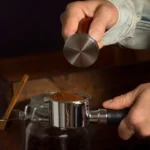Every day, you brew billions of cups of coffee. What happens to all those used grounds? Most often, they head straight to landfills. But these discarded grounds are more than just waste. They hold surprising value. You can use them in many ways, far beyond just making your morning cup.
- How do coffee grounds help your garden and compost pile?
- How can coffee grounds make your home sparkle and smell fresh?
- How do coffee grounds help with natural pest control?
- How do coffee grounds make your skin and hair more beautiful?
- What creative things can you make with coffee grounds in arts and crafts?
- What should you consider and what are the downsides when reusing coffee grounds?
Reusing coffee grounds makes sense. It’s a simple, resourceful habit. These humble leftovers can become useful for your home, your garden, and even your beauty routine. This guide will show you practical, earth-friendly ways to repurpose coffee grounds. Learn how they can help in gardening, cleaning your home, controlling pests, caring for yourself, and making creative crafts.
Using your coffee grounds again cuts down on waste. It saves you money. It also gives you natural, effective fixes for everyday needs. This small step helps you live a more sustainable, eco-friendly life.
How do coffee grounds help your garden and compost pile?
Coffee grounds are a gardener’s secret weapon. They enrich soil and supercharge your compost pile.
How can coffee grounds improve soil and help plants grow?
Coffee grounds make soil healthier. They give your plants important nutrients and improve the soil’s texture. You’ll find vital elements like:
- Nitrogen,
- Phosphorus,
- Potassium,
- Calcium,
- Magnesium,
- And various trace minerals.
Nitrogen is a key nutrient. It helps plants make food and supports strong, healthy growth. The coarse texture of coffee grounds also makes soil structure better. It improves drainage, too. This prevents problems like root rot and plant diseases.
Coffee grounds also help soil hold more water. This is great for plants that love moisture. Think of Hostas, Bleeding Hearts, and Primroses. They thrive with extra water. Adding coffee grounds also puts valuable organic matter into your soil.
How do coffee grounds make your compost pile better?
Coffee grounds give your compost pile a big boost. They act as a “green” material, full of nitrogen. Adding them helps balance the carbon-to-nitrogen ratio. This ratio is vital for quick decomposition.
These grounds create heat in the pile. This speeds up the breakdown process. They also attract helpful microbes, like bacteria and fungi. These tiny helpers are crucial for making nutrient-rich compost. Composting coffee grounds is an easy way to use their full power.
What are important tips for gardeners when using coffee grounds?
When you use coffee grounds in your garden, remember these tips:
- Mix the grounds well into soil or compost. This stops them from clumping. Clumps can form a barrier that repels water, which you don’t want,
- Use them in moderation. They should be no more than 15–20% of your total soil volume. Too much can compact soil or throw off nutrients,
- Understand their pH. Used coffee grounds have a nearly neutral pH (about 6.5–6.8). This means they won’t make soil significantly acidic for most plants. So, they won’t replace special acidifiers for plants like blueberries or azaleas.
How can coffee grounds make your home sparkle and smell fresh?
Coffee grounds offer a natural, non-toxic way to clean your home and remove bad odors. They work well, too.
How do coffee grounds clean like a natural scrub?
Coffee grounds make a great natural scrub. Their gritty, slightly abrasive texture helps you clean tough grime. Use them on kitchen surfaces like countertops, sinks, stovetops, pots, and pans. They easily remove stubborn food bits, grease, and dried spills.
Here’s how to use them:
- Sprinkle grounds on a damp sponge or right onto the surface,
- Scrub gently,
- Rinse well.
Always be careful. Don’t use coffee grounds on porous or delicate surfaces. They might stain or scratch them.
How are coffee grounds a strong odor neutralizer?
Coffee grounds powerfully absorb and neutralize odors. They naturally trap smells. Place a bowl of dry grounds in smelly spots. This works for your refrigerator, freezer, or trash cans.
For shoes, put dry grounds inside a sock or cloth. Leave them in the shoes overnight. They will absorb bad smells. You can also scrub your hands with coffee grounds after handling strong foods. Think garlic or fish. This removes lingering smells.
What are other clever cleaning tricks using coffee grounds?
Try mixing coffee grounds with a little dish soap. This creates a versatile cleaning paste. This paste is excellent for tough stains or scuffs on wood. It can even darken and hide small scratches on wood furniture or floors.
How do coffee grounds help with natural pest control?
Coffee grounds can help you manage certain unwanted visitors around your home and garden. They are an earth-friendly way to keep pests away.
How are coffee grounds good at repelling insects?
Coffee grounds repel insects. Their strong scent and unique properties deter many pests. You can scatter grounds around problem areas to repel ants. The grounds mess up their scent trails, making it hard for them to find their way.
For slugs and snails, make a barrier with coffee grounds around your plants. They don’t like the texture and ingredients. Burning dried coffee grounds creates smoke. This smoke repels flying insects like mosquitoes, bees, and wasps. If you regularly apply coffee grounds around your plant beds, it can also help repel fleas. Plus, you add good organic material to the soil.
Can coffee grounds deter animals?
Coffee grounds might help deter some animals. But know their limits. For example, coffee grounds could mask odors from dead rodents. This might make an area less appealing to other rodents. But there’s not much proof they actively repel live rodents.
Some people say coffee grounds deter stray cats. However, science has not documented this effect as well.
What are the limits and best ways to use coffee grounds for pest control?
Coffee grounds are not a cure-all for every pest. They work best against specific insects and, to a lesser extent, certain animals. When you use them in soil, be careful. Reapply them in moderation. They should be no more than 15–20% of the soil’s volume. This prevents bad effects on your plants.
For tougher pest problems, mix coffee grounds with other natural repellents. Try peppermint oil or citronella. You can sprinkle grounds directly. You can burn dried grounds. Or you can refresh barriers regularly, especially after rain. This keeps them working well.
How do coffee grounds make your skin and hair more beautiful?
Coffee grounds are a natural, affordable addition to your beauty routine. They offer many benefits for your skin and hair.
How are coffee grounds a gentle scrub for your face and body?
Coffee grounds make a gentle, effective exfoliator for both your face and body. Their texture removes dead skin cells. It also unclogs pores. This gives you smoother, brighter skin. You can easily make your own scrub at home. Just mix coffee grounds with natural oils. Try:
- Coconut oil,
- Almond oil,
- Jojoba oil,
- Or sesame oil.
For extra brightening, add brown sugar and a few drops of lemon juice to your scrub. Use this homemade scrub once or twice a week for the best results.
How can coffee grounds be a revitalizing hair treatment?
Coffee grounds can revitalize your hair. Massage them into your scalp. This exfoliates your scalp. It removes product buildup, too. This leads to shinier, healthier hair. Using them regularly, especially mixed with conditioner weekly, may even stimulate hair growth.
What specific treatments can coffee grounds offer for common problems?
Coffee grounds can target common beauty concerns. This is thanks to their unique compounds. For under-eye puffiness, the caffeine in coffee stimulates blood flow. It also tightens skin. This helps reduce swelling and fluid buildup.
For cellulite and stretch marks, regular use of coffee scrubs may lessen their look. Caffeine’s tightening and circulation-boosting effects on the skin drive this benefit.
What creative things can you make with coffee grounds in arts and crafts?
Coffee grounds can be an unexpected art material. They let you create unique, earth-friendly craft projects.
What cool craft projects can you make with coffee grounds?
You can make many cool craft projects by reusing coffee grounds. These are fun, eco-conscious activities:
- Coffee ground fossils: Combine used grounds with flour, salt, and cold coffee. Form a salt dough. Flatten the dough, cut shapes, and press small objects like toy dinosaurs into it. This creates fossil impressions. It’s a unique keepsake, great for kids,
- Painting with coffee: Dilute coffee grounds with water. This makes natural paint. Use it with paintbrushes on paper to create earthy-toned art. It’s a great way to learn about natural dyes,
- Coffee ground candles: Mix used grounds with melted wax. Pour the mixture into molds with wicks. You’ll get rustic, aromatic candles,
- Coffee ground mixed media art: Combine grounds with acrylic or tempera paint for textured pieces. Think of bison landscapes. Add materials like construction paper and chalk pastels for more richness.
What should you consider and what are the downsides when reusing coffee grounds?
Reusing coffee grounds offers many benefits. But some uses come with warnings. You need to think carefully about certain applications.
Why shouldn’t you reuse coffee grounds for brewing?
Don’t reuse coffee grounds for a second brew. The quality drops significantly. The first brew takes out most of the flavor and caffeine. Little is left for later uses. A second brew will be weaker, more bitter, and less flavorful.
Reusing grounds can also increase acidity. This comes from over-extracting the remaining compounds. It leads to an unpleasant taste. The brewing outcome becomes unpredictable. You might get an over-extracted bitter brew. Or you might get an under-extracted weak one. Either way, the caffeine content will be much lower.
What are careful application tips for coffee grounds in gardening?
When you apply coffee grounds in your garden, use them carefully. Avoid harm. Do not apply them in thick layers directly to the soil or use them as mulch. Improper application can cause problems like:
- Soil compaction,
- Inhibited seed germination,
- Nutrient imbalances harmful to plants.
Always use coffee grounds in moderation. Mix them thoroughly with other organic matter. This ensures good airflow and even nutrient spread. It helps prevent any bad effects on your plants.
What are general precautions when reusing coffee grounds?
When you reuse coffee grounds for any purpose, make sure they are fresh. For household or beauty uses, grounds must be fresh enough to prevent mold or bad smells. Always test any cleaning or beauty product on a hidden spot first. This is especially true for porous or delicate surfaces. It helps you avoid staining or damage.
| Category | Benefits of Reusing Coffee Grounds | Key Usage Tips/Considerations |
|---|---|---|
| Gardening | Enriches soil with Nitrogen, Phosphorus, Potassium, Calcium, Magnesium, trace minerals. Improves soil structure and drainage. Increases water retention for moisture-loving plants. Boosts compost piles by adding nitrogen and attracting beneficial microbes. | Mix well into soil (no more than 15–20% of volume). They have a near-neutral pH; do not replace acidifiers for specific plants. |
| Household Cleaning | Acts as a natural, abrasive scrub for kitchen surfaces (countertops, sinks, stovetops, pots, pans). Removes tough food residue, grease, and dried spills. Powerful odor absorber for refrigerators, freezers, trash cans, and shoes. Helps remove pungent smells from hands (garlic, fish). | Avoid porous or delicate surfaces to prevent staining or scratches. Can be mixed with dish soap for a cleaning paste. |
| Pest Control | Deters ants by disrupting scent trails. Creates barriers against slugs and snails. Smoke from burning grounds repels mosquitoes, bees, and wasps. May help repel fleas around plant beds. Can mask odors from deceased rodents. | Not a broad-spectrum solution. Effectiveness varies for different pests/animals. Reapply cautiously in soil (no more than 15–20% of volume). Combine with other repellents for stubborn issues. |
| Beauty & Personal Care | Gentle exfoliator for face and body, removes dead skin cells, unclogs pores. Revitalizing hair treatment when massaged into the scalp, removes product buildup, promotes shinier hair, may stimulate growth. Caffeine helps reduce under-eye puffiness by stimulating blood flow. Regular scrubs may diminish cellulite and stretch mark appearance. | Mix with natural oils for scrubs. Apply scrubs once or twice weekly. Test on a small area first for sensitive skin. |
| Arts & Crafts | Versatile medium for unique, eco-friendly projects. Can be used to create “fossils” in salt dough. Diluted grounds make natural paint for earthy artworks. Can be mixed with wax for rustic, aromatic candles. Adds texture to mixed media art. | Use dried grounds for crafts to prevent mold. Experiment with dilution for different color intensities in painting. |
| Limitations | Significantly diminishes coffee quality if reused for brewing (weak, bitter, unpredictable taste, less caffeine). Improper use in gardening (thick layers) can cause soil compaction, inhibit seed germination, or nutrient imbalances. | Do not reuse for brewing. Use in moderation in gardens, always mixing thoroughly with other organic matter. Ensure freshness for household/beauty uses. Always test applications on inconspicuous areas. |
Reusing coffee grounds opens up a world of practical, earth-friendly advantages for your home and garden. They can enrich your soil, keep pests away, clean your home naturally, and even boost your beauty routine. These used grounds hold incredible hidden value.
This simple habit greatly helps sustainability and cuts down on waste. When you repurpose what you might otherwise throw away, you choose a greener, more resourceful lifestyle. Unlock the full potential of your daily brew. Turn waste into valuable resources.
Start repurposing your coffee grounds today. You will contribute to a greener planet.









